|
For the Chauvin pre-trial essay, “Slugging it Out Before the Fight,” click here
For post-trial motions, sentence and updates, click here
For the State and Federal trials of Lane, Kueng and Thao, click here
For the main essay about George Floyd, “Punishment Isn’t a Cop’s Job,” click here
For our video compilation that tracks the entire encounter, click here
Posted 3/29/21
STATE TRIAL OF DEREK CHAUVIN
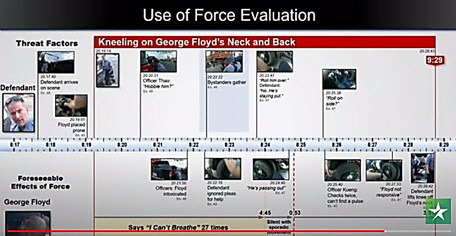
WEEK 1
Opening Arguments (3/29)
During his lengthy, hour-plus statement, Prosecutor Jerry Blackwell focused on three arguments:
- Chauvin “betrayed” his responsibilities as a cop by using force that was excessive by Minneapolis Police regulations alone
- Chauvin applied a neck restraint, a practice that presents an “imminent” risk of death
- That neck restraint cut off Floyd’s oxygen and caused his heart to stop beating. This - not Floyd’s drug abuse - caused his death
That last point is the trial’s key issue. Turning Floyd’s “problems with addiction” to the State’s advantage, prosecutor Blackwell pointed out that Floyd had for years survived drug abuse, high blood pressure and heart disease only to die at the hands of a brutal cop. A time line (see above) was repeatedly used to emphasize Chauvin’s “impassive” application of a lethal restraint technique for “nine minutes and twenty-nine seconds.” About halfway through, after uttering “I can’t breathe” twenty-seven times, Floyd fell silent. But Chauvin persisted until his victim was loaded into an ambulance.
Prosecutor Blackwell’s forceful comments, extensively supplemented with graphic images, were an admittedly tough act to follow. As the Washington Post pointed out, he also had virtually unlimited human and material support. In contrast, Chauvin’s defense lawyer, Eric Nelson, is basically going it alone. That seemed evident from Mr. Nelson’s subdued tone and his presentation’s far shorter duration. Mr. Nelson’s main argument is that Floyd’s death was caused by drug abuse:
Click here for the complete collection of George Floyd essays
- Floyd chronically ingested highly dangerous drugs, including the highly toxic combination of fentanyl and meth. He did so on that day. According to his companions, after Floyd got his smokes with that phony bill he fell asleep in the car and they couldn’t wake him up.
- There was one (official) autopsy, and it revealed the presence of these drugs. There were no tell-tale signs of asphyxiation and there was no evidence that Floyd’s airflow had been restricted. But the State “wasn’t satisfied” with that so they turned to “outsiders.” A reference to excited delirium suggests that the defense may offer testimony that Floyd’s extreme agitation while intoxicated by powerful drugs led his “already compromised heart” to stop beating.
- According to Mr. Nelson, use of force “isn’t attractive” but officers sometimes find it necessary. Floyd was a very large man and struggled mightily. Meanwhile an increasingly large crowd of hostile bystanders gathered. Given that “distraction” the cops on scene did the best they could.
What you’ve read is based on our viewing of the opening arguments. For the Minneapolis Star-Tribune’s far more extensive take click here. And to watch the trial, click here.
PROSECUTION CASE
Day 1 - Monday, March 29 (for the trial video click here)
Jean Scurry, a 9-1-1 operator, took the call from the convenience store where Floyd passed a counterfeit bill. City surveillance cameras let her watch as officers removed Mr. Floyd from a squad car and forcefully placed him on the ground. Alarmed by their protracted use of force, she notified a patrol supervisor. A record of that call was played to the jury:
I don't know, you can call me a snitch if you want to... but we have the cameras up for [squad] 320's call, and…I don't know if they had to use force or not, but they got something out of the back of the squad, and all of them sat on this man, so I don't know if they needed you or not, but they haven't said anything to me yet....
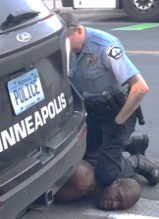 Donald Williams, a mixed martial arts (MMA) fighter, walked up during the incident and saw exactly what the photo depicts. Mr. Williams said that Chauvin’s application of pressure to the side of Floyd’s neck was just like the “blood choke” used in MMA, when fighters press on one side of the neck to impair blood flow to the brain. Chauvin, he said, repeatedly exerted and released pressure, the so-called “shimmy.” That was made evident by movements of Chauvin’s shoulder, leg and foot. In reaction, Floyd gasped for air and repeatedly faded away. “He was going through distress because of the knee.” Eventually Floyd fell silent. His eyes slowly rolled to back of head and blood came out of his nose. He seemingly had no life left. Donald Williams, a mixed martial arts (MMA) fighter, walked up during the incident and saw exactly what the photo depicts. Mr. Williams said that Chauvin’s application of pressure to the side of Floyd’s neck was just like the “blood choke” used in MMA, when fighters press on one side of the neck to impair blood flow to the brain. Chauvin, he said, repeatedly exerted and released pressure, the so-called “shimmy.” That was made evident by movements of Chauvin’s shoulder, leg and foot. In reaction, Floyd gasped for air and repeatedly faded away. “He was going through distress because of the knee.” Eventually Floyd fell silent. His eyes slowly rolled to back of head and blood came out of his nose. He seemingly had no life left.
Day 2 - Tuesday morning, March 30 (for the trial video click here)
On cross-examination, Donald Williams distinguished between a blood choke, which involves pressure to the side of the neck, and an “air choke,” which involves pressing on the front of the neck to cut off oxygen (these are lethal and not used in MMA fights.) Mr. Williams said he’s applied and been on the receiving end of blood chokes. They render fighters unconscious within three to five seconds, and its recipients don’t promptly recover.
Mr. Williams agreed telling FBI agents that “I wanted to beat the shit out of the police officers.” He also admitted calling the officers names. He also admitted threatening an officer who was pushing bystanders away “I dare you to touch me like that I’ll slap...out of you.” But Mr. Williams denied he became angrier as the incident progressed. Instead, he remained professional, just as he does in his everyday security work.
Mr. Williams’ testimony about the near-instantly incapacitating effects of a “blood choke” seem somewhat inconsistent with how Mr. Floyd reacted to his forceful, protracted detention. It may actually give a slight boost to what seems the defense approach, that Mr. Floyd’s poor health, drug abuse and extreme agitation (e.g., “excited delirium”) were actually to blame.
Day 2 - Tuesday afternoon, March 30 (for the trial video click here)
Four young passers-by testified. Three were seventeen at the time and one was nine. Each was deeply upset by Mr. Floyd’s treatment. They were particularly shocked by Chauvin’s impassiveness as he, without letup, pressed a knee against Mr. Floyd’s neck. Chauvin’s lawyer kept cross-examination brief. He focused on the chaotic scene and its distracting influence on police.
Genevieve Hanson, an off-duty firefighter, was the day’s final (and clearly most important) witness. Ms. Hanson, who is 27 and White, has been on the job two years. Out for a stroll, she walked up about five minutes before the ambulance arrived. Ms. Hanson immediately noticed that Mr. Chauvin had a hand in his pocket and “seemed very comfortable, [with] the majority of his weight balanced on top” of his prisoner. But Mr. Floyd was neither talking nor moving. His face “looked puffy and swollen.” Based on experience and training, she quickly determined that Mr. Floyd had “an altered level of consciousness to the point that he wasn’t responding to painful stimuli.” Ms. Hanson said it was critical to confirm that his airway was unobstructed and check for a pulse, and in its absence begin chest compressions. She quickly identified herself as a firefighter and EMT but her offer to help was rudely rebuffed. “You would know better than to get involved,” a cop said. At this point in her testimony she began crying.
Ms. Hanson was present when the ambulance arrived. Its attendants didn’t examine Mr. Floyd but quickly took him away (it relocated to a calmer spot to offer treatment). On cross-examination Ms. Hanson confirmed that the atmosphere on scene likely prompted a “load and go.” She also agreed that the “five or six minute delay” in the fire department’s arrival - paramedics didn’t get there until after the ambulance left - was in her experience “unheard of.” Had there not been “some miscommunication between police and [fire] dispatch [paramedics] would have responded much sooner.”
Ms. Hanson’s testimony was preceded by dramatic bystander video taken during those final moments. We uploaded it here. Two voices are prominent: hers and Mr. Williams’, the MMA fighter who testified earlier. It’s impossible to come away without being shocked by Chauvin’s impassive yet relentless use of force. Watch the clip: he literally didn’t lift his knee until attendants reached down to lift Mr. Floyd into the gurney. (That’s why we entitled our original essay “Punishment Isn’t a Cop’s Job.”) So instead of defending the indefensible, Mr. Chauvin’s lawyer used the witnesses’ testimony to help set the stage for a second defense: that Mr. Floyd would not have died but for delayed medical care caused by bureaucratic foul-ups and a hostile scene.
Day 3 - Wednesday, March 31 (for the trial video click here)
Four witnesses testified. Two citizen observers gave compelling, heart-felt testimony:
Christopher Martin, 19, is the store clerk who accepted the counterfeit $20 bill from Mr. Floyd. He quickly informed his superiors. Mr. Martin later exited the store and watched bystanders gather and loudly protest Mr. Floyd’s rough treatment. He testified that he felt “guilt”: “If I could have just not taken the bill, this could have been avoided.” (Click here for a video of Mr. Martin’s testimony)
Charles McMillian, 61, was present from the moment that officers tried to place Mr. Floyd in their car. Mr. McMillian tried mightily to convince Mr. Floyd to go along with the police, and even suggested that he could ultimately “win.” Mr. McMillian remained on scene and became horrified at Mr. Floyd’s treatment. He testified that the victim’s protests - “I can’t breathe...Mamma, they’re killing me” - have stuck in his mind. Yet officers never tried to give Mr. Floyd any medical aid. Mr. McMillian, who had once briefly chatted with Chauvin, testified that he came across the defendant several days before the trial and wished him well. But he also told Chauvin that what he did to Mr. Floyd was wrong and that he now looked on him as “a maggot.” (Click here for a video of Mr. McMillian’s testimony.)
Aside from manslaughter, Mr. Chauvin has been charged with second and third-degree murder. Neither requires an intent to kill. Third-degree murder carries a 25-year penalty. It requires proof that while “evincing a depraved mind, without regard for human life,” an accused committed “an act eminently dangerous to others.” Second-degree murder, which is punishable by a forty-year term, requires proof that the accused was “committing or attempting to commit a felony offense other than criminal sexual conduct” and using “force or violence.”
Prosecutors are making extensive use of bodycam and security videos and passer-by testimony to prove that Chauvin’s relentless, unreasonable use of force and disinterest in Mr. Floyd’s health evidenced his depravity and unconcern for life. That could be enough for third-degree murder. Witnesses who will testify about police regulations and practices could help prove that Chauvin’s conduct went so far beyond what’s professionally accepted that it breached the threshold of felony assault. If so, it would bring things into second-degree murder territory.
 Given the power of the videos, the defense may find it impossible to “normalize” Mr. Chauvin’s behavior. Instead, they are under increasing pressure to prove that Mr. Floyd’s death was caused by drug abuse and underlying health problems. To that end, one of their best “shots” is that Mr. Floyd was in the throes of excited delirium. During the struggle with Mr. Floyd, officer Thomas Lane mentioned that concern and suggested placing Mr. Floyd on his side. Another officer demurred and said that’s why an ambulance was called. Lane’s body camera captured the exchange. (Click on the image to play this episode, or here for Lane’s entire video.) So Chauvin’s lawyer has a problem. If the officers suspected that Mr. Floyd suffered from a dire condition, proving it may actually disadvantage his client, who never stopped pressing his weight against Mr. Floyd’s neck. Given the power of the videos, the defense may find it impossible to “normalize” Mr. Chauvin’s behavior. Instead, they are under increasing pressure to prove that Mr. Floyd’s death was caused by drug abuse and underlying health problems. To that end, one of their best “shots” is that Mr. Floyd was in the throes of excited delirium. During the struggle with Mr. Floyd, officer Thomas Lane mentioned that concern and suggested placing Mr. Floyd on his side. Another officer demurred and said that’s why an ambulance was called. Lane’s body camera captured the exchange. (Click on the image to play this episode, or here for Lane’s entire video.) So Chauvin’s lawyer has a problem. If the officers suspected that Mr. Floyd suffered from a dire condition, proving it may actually disadvantage his client, who never stopped pressing his weight against Mr. Floyd’s neck.
Day 4 - Thursday, April 1 (for the trial video click here)
Five witnesses testified. Courteney Ross, Floyd's girlfriend, spoke fondly about their close and loving relationship. They had been together for three years. Both had battled a “classic” opioid addiction brought on by the use of prescription pain-relievers and wound up buying drugs illicitly. She thought they had weaned themselves off, but Mr. Floyd’s recent behavior suggested he had relapsed. Ms. Ross agreed telling the FBI that there were times Mr. Floyd was happy and “bouncing around” and other times when he was “unintelligible.” (For her testimony click here.)
Both paramedics who picked up and transported Mr. Floyd testified. They confirmed that he had no pulse, and that they temporarily relocated their ambulance because of the hostile scene. Fire Department Captain Jeremy Norton arrived after the ambulance left. During cross-examination, he agreed that his arrival came twelve minutes after the original call was made. He had little information and started looking around for the patient. As he did so he noticed that citizens were very upset. His partner encountered off-duty firefighter Genevieve Hansen, who seemed “agitated to distraught.” Capt. Norton learned that his patient was injured while struggling with police, and that paramedics picked him up and relocated. He met with them nearby. Floyd was hooked up to various devices and being actively treated, but he was essentially “an unresponsive body on a cot.”
This day’s most compelling testimony was offered by the police supervisor on duty during that shift, Sergeant David Pleoger. (He has since retired. For his testimony click here.) Sergeant Pleoger said that he first heard about possible problems from a dispatcher, who called him and said “she didn’t want to be a snitch” but saw something concerning on camera. Her call was recorded and played in court. In the clip (click here) she mentions that “all of of ‘them’ sat on this man.” But she doesn’t offer other details and her tone is light-hearted. Sergeant Pleoger soon spoke with Chauvin by phone (for the clip click here.) Chauvin told him that Floyd became combative, suffered a medical emergency and was taken away by paramedics.
In line with MPD policy, Sergeant Pleoger went to the scene. He spoke with Chauvin and the other officers, then went to the hospital. In line with department regulations about uses of force that “may have been unreasonable or not within policy” (MPD policy manual p. 242) Sgt. Pleoger notified internal affairs and his superiors. He also commented on MPD policies on use of force. Sgt. Pleoger explained that when persons must be heavily restrained they are placed in a “side recovery position” (MPD policy manual p. 246) as being on one’s chest and stomach can compromise breathing and lead to positional asphyxia. He said this is taught in the academy and its knowledge is  commonplace. But when the prosecutor asked the former police supervisor what he thought about Chauvin’s use of force, the defense objected. After a discussion away from the jury, the judge allowed his opinion about what he observed on the video of the encounter. It was brief and to the point. “When Mr. Floyd was no longer offering up any resistance to the officers they could have ended their restraint.” (Click on image for the brief video clip.) commonplace. But when the prosecutor asked the former police supervisor what he thought about Chauvin’s use of force, the defense objected. After a discussion away from the jury, the judge allowed his opinion about what he observed on the video of the encounter. It was brief and to the point. “When Mr. Floyd was no longer offering up any resistance to the officers they could have ended their restraint.” (Click on image for the brief video clip.)
Chauvin’s former superior clearly did him no favors. If the defense gained anything this day, it was to highlight Floyd’s long-time drug use and the delay in medical response. So the struggle continues.
Day 5 - Friday, April 2 (for the trial video click here)
Two MPD officers were the only witnesses. Sergeant Jon Edwards, who was in charge of the following shift, testified that the encounter with Mr. Floyd was classified as a “critical incident.” That changed MPD’s role. After taping off the area and securing evidence, which included a police car and Mr. Floyd’s vehicle, officers turned the scene over to state agents.
Lieutenant Richard Zimmerman, who heads MPD’s homicide unit, was questioned at length. His testimony would prove devastating to Mr. Chauvin. A thirty-five year veteran of MPD, he is at present its longest-serving officer. Lieutenant Zimmerman joined the agency in 1985 after four years as a sheriff’s deputy. He began his career in patrol, but after five years shifted to narcotics investigations. In 1995 he was assigned to homicide, and that’s where he’s remained.
Lieutenant Zimmerman went to the scene of Mr. Floyd’s death to help secure it until State agents arrived. His important testimony was about the use of force. Lieutenant Zimmerman testified about use of force training and MPD use of force policy. He said that officers undergo yearly training in use of force, and described a key aspect, the “use of force continuum.” (For a brief clip, click here.) That continuum, he said, ranges from an officer’s mere presence, to verbal persuasion, and through intermediate steps such as the use of handcuffs. Ultimately, “if someone is pointing a gun or shooting,” it can reach its most extreme level, the application of deadly force. That set the stage for a key question:
Prosecutor: Have you ever in all the years you’ve been working for the Minneapolis police department been trained to kneel on the neck of someone who is handcuffed behind their back in a prone position?”
Lieutenant Zimmerman: No, I haven’t.
According to the witness, from the moment an officer applies handcuffs it becomes his duty to safeguard a prisoner’s well-being. “That person is yours...his safety is your responsibility.” Lieutenant Zimmerman said that officers have been long cautioned that handcuffing someone behind their back can impair breathing, and to avoid making things worse handcuffed persons should be sat up or placed on the ground on their sides, and not on their chest or stomach. He also pointed out that officers are trained to perform CPR and are expected, if necessary, to intervene medically even if an ambulance is enroute.
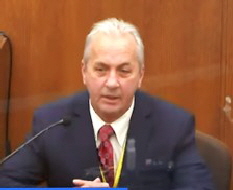 Lieutenant Zimmerman confirmed that he reviewed many videos and observed no change in the amount of force used on Mr. Floyd from the moment he was placed on the ground until paramedics arrived. Then the prosecutor asked the ultimate question: Lieutenant Zimmerman confirmed that he reviewed many videos and observed no change in the amount of force used on Mr. Floyd from the moment he was placed on the ground until paramedics arrived. Then the prosecutor asked the ultimate question:
Prosecutor: What is your view of that use of force during that time period?
Lieutenant Zimmerman: Totally unnecessary. Pulling him down to the ground face down and putting your knee on the neck for that amount of time is just uncalled for. I saw no reasons why the officers felt they were in danger.
Lieutenant Zimmerman was asked if use of force should have ceased once Mr. Floyd was on the ground, handcuffed and not resisting. His response: “Absolutely I would stop.” (Click on the image for a video clip.)
Having little to work with, the defense lawyer obliquely challenged the witnesse’s bonafides by pointing out that he hasn’t been on patrol, thus routinely exposed to encounters with unpredictable sorts, virtually for decades. Lieutenant Zimmerman didn’t argue. (He did mention that his last physical fight was in 2018.) He also agreed that even handcuffed persons can pose a threat. But the impact of his concessions seemed slight. All in all, the long-serving officer’s testimony closed the first week with a gut punch that the defense will find difficult to overcome.
WEEK 2
Day 6 Day 7 Day 8 Day 9 Day 10
PROSECUTION CASE CONTINUES
Day 6 - Monday, April 5 (for the trial video click here)
First up was Dr. Bradford Langenfeld, the emergency physician who attended to Mr. Floyd and ultimately pronounced him dead. On arrival Mr. Floyd was in cardiac arrest. Paramedics said that they never detected a pulse and applied established cardiac support measures, which he continued. But the patient’s heart would never beat on its own “to a degree sufficient to sustain life.” Mr. Floyd’s high CO2 levels suggested the most likely cause of death as hypoxia, an insufficiency of oxygen. As for other causes, there were no indications of external trauma or of a heart attack. He had no information that Mr. Floyd had complained of chest pain, nor that he had overdosed on medication nor taken any drugs. Dr. Langenfeld had also considered “excited delirium,” which he called a “controversial diagnosis,” but had no information that Mr. Floyd had displayed extreme agitation, which is one of its signs.
On cross-examination Dr. Langenfeld agreed that certain drugs can cause hypoxia, and particularly fentanyl, which suppresses the respiratory system. That is the drug Mr. Floyd had reportedly been abusing. (For the Star-Tribune’s summary, click here.)
Police chief Medaria Arradondo was next. Minneapolis’ chief since 2017, he holds the distinction of having sued having sued his own agency “for tolerating racism.” A Minneapolis native with a Master’s degree in Criminal Justice, he joined the agency in 1989 and has served in virtually every role. He was selected as Chief in 1987, after an officer shot and killed Justine Diamond. (That event led to the departure of then-chief Janee Harteau and a $20 million settlement, second only to the $27 million paid to Mr. Floyd’s family.)
In his testimony, Chief Arradondo described officers’ role as “guardians” and emphasized their obligation to treat people with “dignity and compassion.” These values, he testified, lie at the core of MPD’s “professional policing policy” (MPD manual sec. 5-1204.01, p. 218.) One requirement, which he read aloud, was to minimize the length of detention.
Chief Arradondo stressed de-escalation. “Trying to provide an opportunity to stabilize the situation, de-escalate it; the goal is to have a faith in people outcome.” He said it became a hot topic at MPD because of an incident several years ago. (MPD has experienced a string of use-of-force disasters. Click here.) Last revised in 2016, MPD’s de-escalation policy instructs officers to consider several factors. Chief Arradondo highlighted two: citizens may be under the influence of alcohol or drugs or experiencing a “behavioral crisis.” Referring to the MPD’s crisis intervention policy (MPD manual sec. 7-809, p. 427) he mentioned that de-escalating so as to avoid using force is official policy, even for suspects who may have themselves brought things on.
According to the witness, MPD officers receive training and have basic tools to provide first aid, from aiding ventilation to stopping bleeding, and often do so with success. Policy requires they act even if EMS is responding (MPD manual sec. 7-350, p. 382.) Officers also have NARCAN for drug overdoses.
Questioning then turned to the issue of the day: use of force (MPD manual sections beginning at 5-301, p. 228.) Chief Arradondo explained the goal as “sanctity of life,” meaning officers and citizens both. Force, he explained, is “any physical contact” that might harm or injure. MPD policy and State law (sec. 609.06) requires it be “objectively reasonable.” He discussed three considerations from the leading Supreme Court case on point, Graham v. Connor: severity of the crime, immediacy of the threat, and whether resistance or flight are involved. Asked about the misconduct that prompted MPD’s contact with Floyd, Chief Arradondo said it was not a violent crime; considering jail capacity, it would “typically not” lead to a “custodial arrest.”
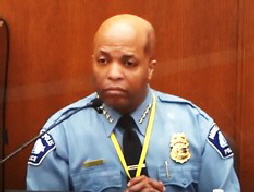 Chief Arradondo testified that the duty to care extends to persons who are resisting. Prosecutors then asked that one question they wished there was no need for. It was about chokeholds and neck restraints. Their witness conceded that the latter had been authorized and taught during training. An outtake from MPD Manual sec. 5-311 was projected. (It’s no longer in force.) Restraints were applied to the side of the neck. They were either “conscious,” using “light to moderate” pressure, or “unconscious,” using “adequate” pressure to render someone, well, unconscious. Chief Arradondo testified that the duty to care extends to persons who are resisting. Prosecutors then asked that one question they wished there was no need for. It was about chokeholds and neck restraints. Their witness conceded that the latter had been authorized and taught during training. An outtake from MPD Manual sec. 5-311 was projected. (It’s no longer in force.) Restraints were applied to the side of the neck. They were either “conscious,” using “light to moderate” pressure, or “unconscious,” using “adequate” pressure to render someone, well, unconscious.
After that embarrassing interlude - click on the image for the video - the Chief delivered his evaluation of what Chauvin did. He “absolutely does not agree” that Chauvin followed MPD de-escalation policy. Neither did he follow policy on reasonable force. Force has to be “objectively reasonable” and take circumstances and threat to officers into account. Chauvin’s application was not a “trained Minneapolis police department defensive technique.” Mr. Floyd’s facial expression did not reflect “light to moderate pressure.” Chauvin should have also stopped applying force when Mr. Floyd stopped resisting, and certainly once he was in distress, then unresponsive. “There was an initial reasonableness,” but it quickly went away. Chief Arradondo also criticized the officers for violating policy by not rendering aid.
On cross-examination, the witness conceded that policy had allowed neck restraints. But Chief Arradondo said it was contrary to training to apply it “for an indefinite period of time.” He added that threat to officers, severity of crime and medical condition are also important. Given all that, he “vehemently” disagreed that Chauvin’s use of force was appropriate. Mr. Floyd’s restraint was depicted on video clips taken from cameras in two positions. Chief Arradondo said he was not familiar with the term “camera perspective bias.” He agreed that on one clip it seemed that Mr. Chauvin’s knee “was more on Mr. Floyd’s shoulder blade” than on his neck.
On redirect the prosecutor addressed the Chief’s “shoulder blade” comment. Chief Arrandondo said the clips shown had been taken shortly before the ambulance arrived, and that was the first time that Mr. Chauvin’s knee was in the shoulder blade area. He said that departmental policy instructs officers to place persons who are being “maximally” restrained or transported on their sides to avoid positional asphyxia.
MPD Inspector Katie Blackwell was the day’s final witness. She became a police officer in 2002 and was in charge of training when the incident occurred. She testified that officers are trained about positional asphyxia, excited delirium and opioids, and that Chauvin received a full day of in-service training in December 2018 on patrol operations and defensive tactics. Inspector Blackwell reiterated the dangers of positional asphyxia and said that officers have for many years been told to place persons on their sides. She also testified that Chauvin’s use of his knee was not how officers were instructed to apply the neck restraint then in use; instead, they were told to apply pressure with one or both arms.

In all, the questioning highlighted two vulnerabilities in the prosecution’s case. When Dr. Langenfeld treated Mr. Floyd and ruled out drugs or “excited delirium” as a cause he was unaware that Mr. Floyd had recently ingested dangerous drugs and was highly agitated and physically aggressive during the initial stages of the encounter. More importantly, as we mentioned in our original essay, “Punishment Isn’t a Cop’s Job,” MPD policy (MPD Manual sec. 5-311) then allowed the use of neck restraints, using an arm or leg (see wording above.) Chauvin’s relentless application of his knee, while criticized as flawed and excessively lengthy, was not nearly as “out of policy” as the witnesses suggested. What the prosecutor, chief and inspector carefully avoided conceding seems obvious: MPD’s policy that allowed neck restraints - since rescinded - was itself deeply flawed from the start.
Day 7 - Tuesday, April 6 (for the trial video click here)
Four officers testified about use of force issues. Minneapolis Police Dept. Sergeant Ker Yang, MPD’s Crisis Intervention Training Coordinator, was first at bat. He is a 24-year department veteran and holds a doctorate in psychology. Sergeant Yang testified about MPD’s decision-making model, which guides officers as they gather information, identify threats, determine if they have authority to act, and settle on the most appropriate approach. On cross-examination, he agreed that officers may need to act in ways that look “bad” and that bystanders may not understand and provoke a “crisis.” Creating “time and distance,” he agreed, is important to de-escalation. He also agreed that appearing calm and confident and speaking softly are useful when dealing with fraught situations.
MPD Lieutenant Johnny Mercil was next. An officer since 1196, Lieutenant Mercil works in the training division and has served as a use-of-force instructor. He has also been been involved in the martial arts. Lieutenant Mercil emphasized that officers should use the least amount of force necessary. He introduced a training graphic that indicates officers should reduce the amount of force as resistance lessens. Lieutenant Mercil described the training he gave on neck restraints when they were in use. He testified that policy required suspects be actively resisting before a neck restraint could be applied. The technique then authorized only involved the use of an officer’s arms. Lieutenant Mercil described a martial-arts neck restraint that uses one’s inner thigh and arm. But that was never adopted into training.
On cross-examination, he agreed that chokeholds involve pressure to the front of the neck, and that the videos did not show Chauvin using a chokehold. Lieutenant Mercil also agreed that rendering someone unconscious with a neck restraint requires pressure to both sides of the neck. He confirmed that using one’s body weight to hold a suspect down is occasionally necessary. He also agreed that two of the images depicted Chauvin’s knee between Floyd’s shoulder blades. On re-direct, Lieutenant Mercil said that when someone is no longer resisting “it’s time to de-escalate force.” He agreed that holding someone prone can lead to positional asphyxia, and that the risk is increased by adding one’s body weight. He reiterated that suspects should not be forcefully held down after they have stopped resisting.
Testimony was also offered by Officer Nicole Mackenzie, a six-year MPD veteran and former EMT who coordinates medical support for the agency. She testified that in-service officers receive CPR and “EMR” (emergency medical responder) training every year. In addition, policy requires that in critical medical situations officers must immediately render first aid and not just wait for an ambulance.
On cross-examination, Officer Mackenzie confirmed that EMR is a lower-level form of training than EMT. She also discussed the one-hour block of instruction she teaches at the academy on “excited delirium.” Officer Mackenzie testified that persons who exhibit this syndrome are often under the influence of drugs. They may be insensitive to pain, “break things” and display “superhuman strength.” She confirmed that occasionally paramedics “load and go” instead of treating persons on scene. She said that one reason was a “hostile or volatile crowd.”
Los Angeles Police Dept. Sgt. Jody Stiger, a 28-year veteran of the Southern California force, appeared as an expert on use of force. Sergeant Stiger is currently the sole police officer and use-of-force expert for the agency’s Inspector General. He reviewed all available videos about the arrest of Mr. Floyd, as well as reports, MPD manuals and training material. From the beginning, his testimony and the prosecutor’s questions would explicitly refer to the standards imposed by Graham v. Connor, the leading Supreme Court decision on police use of force. Here is an outtake about that opinion from our 2017 essay, “An Illusory Consensus”:
Graham v. Connor, the Supreme Court’s landmark decision on use of force, makes no special distinction as to deadly force. According to Graham, “whether officers’ actions are objectively reasonable” must be analyzed “in light of the facts and circumstances confronting them,” using “the perspective of a reasonable officer on the scene.” These “facts and circumstances” include “the severity of the crime at issue, whether the suspect poses an immediate threat to the safety of the officers or others, and whether he is actively resisting arrest or attempting to evade arrest by flight.”
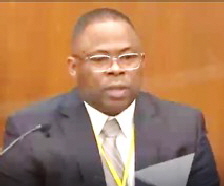 Sergeant Stiger was asked about the use of force against Mr. Floyd. “My opinion was that the force was excessive.” Considering the lesser severity of his crime - passing a counterfeit $20 bill - “you wouldn’t expect to use any type of force.” But did his size present a threat? Size, the witness conceded, can increase risk, but threat isn’t about a person’s size but their actions. Sergeant Stiger noted that Mr. Floyd did at first “actively resist,” so the initial use of force was proper. But “once he was placed on the prone position on the ground he slowly ceased his resistance and at that point the officers should have slowed down or stopped their force.” (For his remarks click on the image.) Sergeant Stiger was asked about the use of force against Mr. Floyd. “My opinion was that the force was excessive.” Considering the lesser severity of his crime - passing a counterfeit $20 bill - “you wouldn’t expect to use any type of force.” But did his size present a threat? Size, the witness conceded, can increase risk, but threat isn’t about a person’s size but their actions. Sergeant Stiger noted that Mr. Floyd did at first “actively resist,” so the initial use of force was proper. But “once he was placed on the prone position on the ground he slowly ceased his resistance and at that point the officers should have slowed down or stopped their force.” (For his remarks click on the image.)
Sergeant Stiger felt that officers used reasonable force in trying to get Mr. Floyd in the car. At that point he was actively resisting. When officers then brought Mr. Floyd out of the car his only aggressive behavior was to kick his legs. Even that, the witness said, soon stopped. Once on the ground, Mr. Floyd “was starting to comply and his aggression was starting to cease.” Sergeant Stiger commented on “positional asphyxia.” He said it can be brought on by placing a prisoner on their stomach, and avoided by placing them on their side. (It was illustrated with a visual that depicts a prisoner restrained with the “Hobble” and lying on their side.) Sergeant Stiger said he heard Mr. Chauvin refer to a Hobble. It wasn’t applied, he thought, because Mr. Floyd had ceased resisting.
Sergeant Stiger’s examination was continued to Day 8.
Day 8 - Wednesday, April 7 (for the trial video click here)
L.A.P.D. Sergeant Stiger returned to the stand. He commented on a series of five still images taken during the nine-and-one half minutes he was restrained and on the ground. (Counter-clockwise from top left.) Chauvin had his left knee on Mr. Floyd’s neck area and his right knee on his back throughout. He said that none of the three Graham v. Connor factors in MPD’s use of force rules - severity of crime, immediate threat to officer safety, active resistance - would have allowed the use of force during that period. Once Mr. Floyd was handcuffed and on the ground, “no force should have been used.” Sergeant Steiger reiterated the risk positional asphyxia, made even worse by officer body weight. restrained and on the ground. (Counter-clockwise from top left.) Chauvin had his left knee on Mr. Floyd’s neck area and his right knee on his back throughout. He said that none of the three Graham v. Connor factors in MPD’s use of force rules - severity of crime, immediate threat to officer safety, active resistance - would have allowed the use of force during that period. Once Mr. Floyd was handcuffed and on the ground, “no force should have been used.” Sergeant Steiger reiterated the risk positional asphyxia, made even worse by officer body weight.
On cross-examination Chauvin’s lawyer pointed out that situational risks are fluid and can abruptly change. Sergeant Stiger agreed. After all, when Chauvin first arrived he observed a large man actively resisting. Sergeant Stiger testified that the officers were then using reasonable force, and agreed that Chauvin could have used a Taser but didn’t. He also agreed that handcuffed suspects can continue to present a risk, and if they keep kicking officers may need to use force. Sergeant Stiger said he once had a suspect who passed out come back fighting. He also agreed that photos don’t capture shifts in weight.
On redirect, the prosecutor asked two questions: When Chauvin was first encountered was he clearly in distress, and would a “reasonable officer” have taken that into account. “Yes” the sergeant replied to both. He was then asked to comment on the reasonableness of Chauvin’s actions, as depicted on the videos. Once again, Sergeant Stiger said that during the period while Floyd was being restrained on the ground, the force used by the defendant “was not objectively reasonable.”
Senior Special Agent James Reyerson, Minnesota Bureau of Criminal Apprehension was next. He currently works in a unit that focuses on police use of force and has been the principal agent on this matter. He arrived on scene that evening, gathered evidence, including two $20 bills and a pipe that were in an envelope on the police car, and had the police car and Mr. Floyd’s vehicle towed. He reviewed bodycam and bystander videos. He agreed that Mr. Floyd stopped making verbal sounds about four minutes after he was placed on the ground and stopped moving altogether about three minutes later. However, Agent Reyerson said that Mr. Chauvin kept applying pressure.
On cross examination Chauvin’s lawyer played one of the videos and the witness confirmed that he heard Floyd said “I ate too many drugs.” But Agent Reyerson changed his mind when on redirect the prosecutor played a longer clip. This time he heard Floyd say “I ain’t do no drugs.” Then on re-cross examination he watched a video depicting activity in and around Floyd’s car, which remained parked across the street during Floyd’s detention. He agreed with the defense lawyer that it seemed a man was throwing something away, and that their doing so may have been prompted by the police presence.
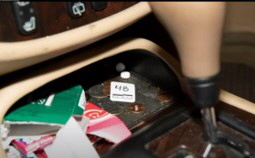 Three forensic technicians also testified. The pipe that officers removed from Mr. Floyd’s car tested positive for THC (marijuana.) Blood stains in the police car’s back seat area were matched to Mr. Floyd. A partial pill and “remnants” found in the police car were also positive for his DNA. These, along with two pills found in the center console of Mr. Floyd’s vehicle (photo, tagged as exh. #48) tested positive for methamphetamine and fentanyl. Three forensic technicians also testified. The pipe that officers removed from Mr. Floyd’s car tested positive for THC (marijuana.) Blood stains in the police car’s back seat area were matched to Mr. Floyd. A partial pill and “remnants” found in the police car were also positive for his DNA. These, along with two pills found in the center console of Mr. Floyd’s vehicle (photo, tagged as exh. #48) tested positive for methamphetamine and fentanyl.
Day 9 - Thursday, April 8 (for the trial video click here)
Three medical experts testified. Dr. Martin Tobin, a Chicago pulmonary and critical care physician was first. He presented a graphic and seemingly compelling account. After studying the videos, he concluded that Mr. Floyd’s prone position, the officers’ tight physical hold, and particularly Chauvin’s pressure with his knees on the neck and elsewhere, “enormously 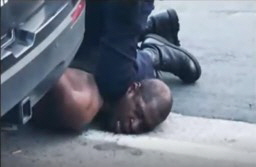 impaired” Mr. Floyd’s ability to breathe. Dr. Tobin estimated that in the infamous photo Chauvin in effect exerted half his body weight on Mr. Floyd’s neck. Among other things, this severely compressed his hypopharynx, a tube that passes air to the lungs. Dr. Tobin said that he visually observed Mr. Floyd lose consciousness at 8:24:53 (click on image at left for a brief video.) He testified that Mr. Floyd stopped breathing at 8:25:16, and that twenty-five seconds later “there was not an ounce of oxygen left in his body.” But Chauvin’s knee remained on Mr. Floyd’s neck for another three minutes. impaired” Mr. Floyd’s ability to breathe. Dr. Tobin estimated that in the infamous photo Chauvin in effect exerted half his body weight on Mr. Floyd’s neck. Among other things, this severely compressed his hypopharynx, a tube that passes air to the lungs. Dr. Tobin said that he visually observed Mr. Floyd lose consciousness at 8:24:53 (click on image at left for a brief video.) He testified that Mr. Floyd stopped breathing at 8:25:16, and that twenty-five seconds later “there was not an ounce of oxygen left in his body.” But Chauvin’s knee remained on Mr. Floyd’s neck for another three minutes.
On cross-examination, Dr. Torbin testified that fentanyl depresses respiration within about five minutes of ingestion. The defense attorney then pointed out that a tablet containing fentanyl along with residue were found in the back of the police car in which officers struggled with Chauvin, and that the struggle took place about five minutes before he apparently stopped breathing.
Forensic toxicologist Daniel Isenschmid was up next. He testified that Mr. Floyd’s blood fentanyl concentration was far lower than what was found in a large sample of homicide victims, and only slightly higher than in a sample of persons arrested for DUI. His methamphetamine blood levels were also very low. On cross-examination Dr. Isenschmid conceded that that in the deaths by homicide sample, the actual causes of death, whether by shooting, drugs or a combination of the two, was unknown.
He was followed on the stand by Dr. Bill Smock, an expert in medical forensics and former E.R. doctor. He said he reviewed videos, medical records and police reports in great detail. Dr. Smock testified that in his opinion, Mr. Floyd died from positional asphyxia caused by pressure on his chest and back. Dr. Smock said he had considered “excited delirium” and discussed the syndrome at length. He said that while it’s controversial and remains unaccepted by either the AMA or APA - “in my opinion it is real.”
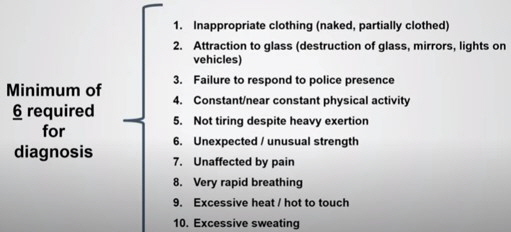 |
Excited delirium is accepted by the American College of Emergency Physicians. According to Dr. Smock there are ten symptoms, of which six must be present for a diagnosis. He went through the list and said that none applied to Mr. Floyd. He was verbally responsive, “answering appropriate questions, giving appropriate answers” (item 3.) His activity level wasn’t “ninety miles an hour” (item 4.) And he did tire, “to the point where he stops breathing” (item 5.) As for unexpected strength, Mr. Floyd wasn’t able to “throw those police officers off who have him on the ground.” He also repeatedly complained of pain, and emergency room doctors found him cool to the touch. Neither did he seem to be sweating.
Dr. Smock’s opinion about the applicability of ExDS to this case seemed purposely tilted in the State’s favor. But it wasn’t challenged on cross-examination. Instead, Chauvin’s lawyer concentrated on Mr. Floyd’s fentanyl/methamphetamine pills. Dr. Smock agreed that these pills could pose special risks and said that he knew a partial pill and residue bearing Mr. Floyd’s DNA were found in the back of the patrol car. But he shrugged off the defense lawyer’s observation that Mr. Floyd complained he couldn’t breathe when he was in that car, without anyone on his back.
Day 10 - Friday, April 9 (for the trial video click here)
Two witnesses testified. Forensic pathologist Dr. Lindsey Carol Thomas was first. She said that she had reviewed a host of materials, including the autopsy report, medical records, and photos and videos taken on scene. She agreed that, as shown on the death certificate, Mr. Floyd’s death was caused by “cardiopulmonary arrest complicating law enforcement subdual, restraint, and neck compression”:
Dr. Thomas said that “cardiopulmonary” meant that neither his heart nor lungs were working. As for the “complicating” wording, it meant that death came because of the officer’s actions. In her opinion “the primary mechanism of death is asphyxia, or low oxygen.” That, she said, was caused by the forceful restraint and prevented Mr. Floyd’s body from functioning as it should. The autopsy ruled out other causes such as a broken neck, or a stroke or heart attack. Videos showed what happened to Mr. Floyd’s breathing. “This was not a sudden death” as she would expect from a heart attack, or a gradual, sleepy death as in a fentanyl overdose.
The prosecutor displayed an outtake from the medical examiner’s press release. It mentioned “other significant conditions” beyond those listed under cause of death:
 |
Dr. Thomas did not comment on these. She also criticized recent studies that purportedly show prone restraints are safe as being done in laboratories and having “no resemblance” to real-world situations.
On cross-examination Dr. Thomas confirmed that Mr. Floyd’s heart was “slightly” enlarged, that his right coronary artery was ninety-percent occluded, and that exertion and “fight or flight” increase the heart’s need for blood and oxygen. Floyd’s heart had to work very hard during the encounter. Had he been found dead at home with no police involvement, “I would conclude that his death was caused by heart disease.” She confirmed that there is no safe level of methamphetamine, which causes a heart to work harder and increases its need for oxygen. On re-direct, the prosecutor ridiculed the defense attempt to take Mr. Floyd’s forceful and prolonged restraint out of the picture. Ms. Thomas stated that as a pathologist what actually took place is critical, and she re-asserted that restraint and neck compression caused Mr. Floyd’s death. She also said that the drugs found in Mr. Floyd’s system were in very small amounts.
Dr. Andrew Michael Baker, the county’s chief medical examiner, took the stand. He had performed the autopsy. Dr. Baker testified that Mr. Floyd’s enlarged and diseased heart required extra oxygen, but the narrowing of his coronary arteries interfered. During the altercation stress hormones would have “poured“ out and caused the heart to beast faster. “In my opinion, the law enforcement subdual restraint and neck compression was just more than Mr. Floyd could take by virtue of those heart conditions” (click here for a brief video clip.)
On cross-examination Dr. Baker confirmed that he watched videos of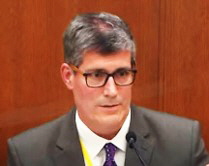 the encounter, but only after performing the autopsy. He reiterated that Mr. Floyd’s heart condition was very significant, and that he told the D.A. that the autopsy did not reveal physical evidence of hypoxia. Dr. Baker also confirmed telling the D.A. that Mr. Floyd’s level of fentanyl would have been fatal “in other circumstances.” Had Mr. Floyd simply been found dead at home, Dr. Baker would have attributed the cause of death to Fentanyl toxicity (click here for a brief video clip.) the encounter, but only after performing the autopsy. He reiterated that Mr. Floyd’s heart condition was very significant, and that he told the D.A. that the autopsy did not reveal physical evidence of hypoxia. Dr. Baker also confirmed telling the D.A. that Mr. Floyd’s level of fentanyl would have been fatal “in other circumstances.” Had Mr. Floyd simply been found dead at home, Dr. Baker would have attributed the cause of death to Fentanyl toxicity (click here for a brief video clip.)
WEEK 3
Day 11 Day 12 Day 13 Day 14
PROSECUTION CASE CONTINUES
Day 11 - Monday, April 12 (for the trial video click here)
Outside the jury’s presence, the defense attorney argued that one of Mr. Floyd’s passengers that day, “Mr. Hall,” gave Texas authorities a recorded statement to the effect that Mr. Floyd ingested drugs and had to be repeatedly shaken awake while they sat in the car after going to Cup Foods. That testimony, he said, is crucial because prosecutors “have gone to great lengths to establish that fentanyl or controlled substances did not play a role in Mr. Floyd’s death.” Chauvin’s lawyer wants to play “Mr. Hall’s” statement in court. But “Mr. Hall” has invoked the Fifth, and the State refuses to grant him use immunity. (“Mr. Hall” is the man whom Special Agent Reyerson said threw something away while officers dealt with Mr. Floyd across the street. See Day 8.)
Dr. Jonathan Rich, a cardiologist who works in intensive care, was up first. Many of his patients have low oxygen levels and require help breathing. He said that the  cause of death was cardiopulmonary arrest. “It was caused by low oxygen levels, and those low oxygen levels were induced by the prone restraint and positional asphyxiation that he was subjected to.” Dr. Rich stated that his prone restraint prevented Mr. Floyd from using the muscles that help one breathe. Dr. Rich testified that neither heart problems nor a drug overdose played a role. Mr. Floyd was never diagnosed with heart disease. He did have high blood pressure, anxiety, and “struggled with substance abuse.” But none of these would have caused him to stop breathing. (Click on image for a brief clip of his conclusions.) Dr. Rich specifically ruled out fentanyl and methamphetamines. His review of E.R. records indicated that Mr. Floyd’s drug use led him to develop “a high degree of tolerance” which he manifested in his alertness, the opposite of what an overdose would bring. Dr. Rich mentioned that on a video he heard one officer suggest turning Mr. Floyd on his side. But Chauvin said “no.” An officer also said “he doesn’t have one,” meaning a pulse. Had Chauvin begun CPR it could have saved Mr. Floyd’s life. cause of death was cardiopulmonary arrest. “It was caused by low oxygen levels, and those low oxygen levels were induced by the prone restraint and positional asphyxiation that he was subjected to.” Dr. Rich stated that his prone restraint prevented Mr. Floyd from using the muscles that help one breathe. Dr. Rich testified that neither heart problems nor a drug overdose played a role. Mr. Floyd was never diagnosed with heart disease. He did have high blood pressure, anxiety, and “struggled with substance abuse.” But none of these would have caused him to stop breathing. (Click on image for a brief clip of his conclusions.) Dr. Rich specifically ruled out fentanyl and methamphetamines. His review of E.R. records indicated that Mr. Floyd’s drug use led him to develop “a high degree of tolerance” which he manifested in his alertness, the opposite of what an overdose would bring. Dr. Rich mentioned that on a video he heard one officer suggest turning Mr. Floyd on his side. But Chauvin said “no.” An officer also said “he doesn’t have one,” meaning a pulse. Had Chauvin begun CPR it could have saved Mr. Floyd’s life.
On cross-examination, Dr. Rich was asked whether Mr. Floyd would have survived had he simply gotten in the back of the police car. Dr. Rich said that he saw no reason why Mr. Floyd would not have survived that day but for the prone positional restraint. On re-cross he was asked whether a combination of factors, including drugs, high blood pressure, coronary heart disease, and increased adrenalin from the struggle could cause death “even in the absence of a prone restraint.” Dr. Rich was asked “yes” or “no.” But he answered in his own way: “Upon my reviews of the facts of this case, I found no evidence to support that.”
Philonise Oneil Floid, 39, George Floyd’s younger brother, was next. He said that Mr. Floyd had been exceptionally close to their mother during his childhood. During her final years she lived with Philonise and his family at their home in Texas. Mr. Floyd was devastated by her death in May 2018 and repeatedly cried “Mama,” “Mama” at her funeral. That was the last time Philonise, a Texas resident, saw his brother. But they stayed in touch. That was the extent of this witnesse’s testimony, and he was not cross-examined.
Seth Wane Stoughton, a law professor, was the day’s final witness. He spent five years as a police officer and has written extensively about use of force and police tactics. Dr. Stoughton relied on the Graham v. Connor factors - severity of the crime, immediacy of the threat, and whether there was active resistance or flight - to analyze this case. Dr. Stoughton said that threat comprises the “ability, opportunity and intention” to cause harm. “Risk” (someone’s size, or drug use) infers a potential threat, but can’t by itself justify the use of force. And once he was handcuffed, Mr. Floyd ceased being a threat. After all, he was vastly outnumbered.
Dr. Stoughton’s analysis focused 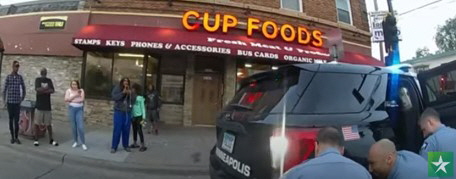 on Chauvin’s use of his knee and on Mr. Floyd’s prone restraint during those nine-plus minutes. He observed that Mr. Floyd’s condition visibly deteriorated. Prone restraint is only supposed to be transitory, and promptly placing someone on their side is crucial to avoid positional asphyxia. Indeed, an officer suggested putting Mr. Floyd on his side. But Chauvin said “no.” A bystander soon announced that Mr. Floyd had passed out, and an officer confirmed it: “he’s passing out.” Mr. Floyd had turned silent, and an officer couldn’t detect a pulse (click here for a brief video clip.) Yet the restraint continued. On re-direct he agreed a “situationally aware” officer would know that “they’re kneeling on top of a limp person.” on Chauvin’s use of his knee and on Mr. Floyd’s prone restraint during those nine-plus minutes. He observed that Mr. Floyd’s condition visibly deteriorated. Prone restraint is only supposed to be transitory, and promptly placing someone on their side is crucial to avoid positional asphyxia. Indeed, an officer suggested putting Mr. Floyd on his side. But Chauvin said “no.” A bystander soon announced that Mr. Floyd had passed out, and an officer confirmed it: “he’s passing out.” Mr. Floyd had turned silent, and an officer couldn’t detect a pulse (click here for a brief video clip.) Yet the restraint continued. On re-direct he agreed a “situationally aware” officer would know that “they’re kneeling on top of a limp person.”
On cross-examination, Dr. Stoughton insisted that placing an already-handcuffed Mr. Floyd into the prone position “was unreasonable, excessive and contrary to generally accepted police practices.” He didn’t think that “reasonable minds” would disagree. He openly disagreed with LAPD Sgt. Stiger, a prosecution witness who endorsed the officers’ initial use of the prone position (see Day 8.)
DEFENSE CASE
Day 12 - Tuesday, April 13 (for the trial video click here)
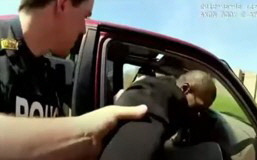 Retired MPD officer Scott Creighton was the first witness called by the defense. He spent the last decade of his long career working in a street narcotics unit. His testimony’s purpose was limited by the judge to describing the effects opiate use may have had on Mr. Floyd. Ex-officer Creighton related an interaction he and two other officers had with Mr. Floyd, who was a passenger in a vehicle they stopped on May 6, 2019. Mr. Floyd was “unresponsive,” “non-compliant,” “nervous” and “anxious.” One of the other officers repeatedly yelled “open your mouth, spit out what you got.” With some difficulty Mr. Floyd was taken out of the vehicle and handcuffed. (Click on the image for the clip.) Retired MPD officer Scott Creighton was the first witness called by the defense. He spent the last decade of his long career working in a street narcotics unit. His testimony’s purpose was limited by the judge to describing the effects opiate use may have had on Mr. Floyd. Ex-officer Creighton related an interaction he and two other officers had with Mr. Floyd, who was a passenger in a vehicle they stopped on May 6, 2019. Mr. Floyd was “unresponsive,” “non-compliant,” “nervous” and “anxious.” One of the other officers repeatedly yelled “open your mouth, spit out what you got.” With some difficulty Mr. Floyd was taken out of the vehicle and handcuffed. (Click on the image for the clip.)
On cross-examination ex-officer Creighton said that Mr. Floyd was “incoherent.” He agreed with prosecutor’s comments that Mr. Floyd could walk, that he “did not collapse on the ground” and that he didn’t “drop dead.”
Retired Hennepin County paramedic Michelle Moseng was next. She went to the police station to attend to Mr. Floyd during the above episode. Mr. Floyd told her that he had been downing an opioid every twenty minutes and took one as an officer approached. She recorded his blood pressure as 216/160. “Based on that and other issues” Mr. Floyd was taken to the hospital. On cross-examination Ms. Moseng said that Mr. Floyd told her he was taking the pills “because he was addicted.”
Shawanda Hill a friend of Mr. Floyd, was third on the stand. She crossed paths with him in Cup Foods on the day of his death. He seemed fine. Mr. Floyd offered to give her a ride home and she accompanied him to his car. While they were parked Ms. Hill was distracted by a phone call. While she was on the phone Mr. Floyd fell asleep. Employees of Cup Foods then came to the car. She repeatedly tried to wake Mr. Floyd but couldn’t. Police officers then came to the car and woke Mr. Floyd.
On cross examination Ms. Hill said “no” when asked if Mr. Floyd complained about shortness of breath or chest pains. She agreed that he otherwise seemed normal.
Minneapolis Park Police Officer Peter Chang was fourth to testify. He was dispatched to back up the MPD officers who detained Mr. Floyd. When he arrived he was asked to watch over Mr. Floyd’s car. He went there and shooed away two persons from the car (one was Shawanda Hill, the other was the “Mr. Hall” mentioned in Day 11.) From that vantage point he observed a crowd gather by the MPD officers. “It was becoming loud and aggressive” and he became concerned about their safety. He observed the volume increase and the attitude worsen over time.
On cross-examination officer Chang conceded that he never heard the MPD officers call on the radio for help. He was asked to watch Mr. Floyd’s car, and that’s what he did.
MPD medical support coordinator Officer Nicole Mackenzie was next. Officer Mackenzie provides academy and inservice training. Academy cadets (but not in-service officers) get training about “excited delirium”. Officer Lane, a recent academy graduate, was trained on this syndrome. Ms. McKenzie said that ExDS is evidenced by the presence of multiple symptoms, which can include incoherence, “superhuman strength,” hyperthermia, psychotic behavior, and violent resistance. Causes include cardiovascular disease, drug use, and mental health issues. Persons in the throes of an ExDS episode need to be restrained. Medical help must be summoned because ExDS can quickly bring on cardiac arrest.
On cross-examination Officer Mackenzie agreed that ExDS could compromise breathing. She said that officers are told to place persons suffering from ExDS in the side recovery position to facilitate breathing. Officer Mackenzie also confirmed that policy requires officers to initiate CPR if someone becomes unresponsive, and that in-service officers such as Chauvin are regularly trained in CPR.
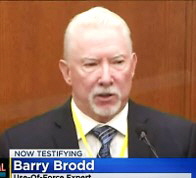 The day’s final witness was Barry Brodd. A retired police officer, he testified as a use of force expert. Mr. Brodd said that he has done so extensively around the U.S. Sometimes he’s found that officers used too much force. But not in this case. After reviewing videos and other materials, he expressed the opinion that “Derek Chauvin was justified, was acting with objective reasonableness, following Minneapolis Police Department policy.” Mr. Brodd said that he uses the Graham v. Connor standard, which focuses on what a reasonable officer would do under similar circumstances. He agreed that one of its factors, severity of the offense, is important. However, Mr. Brodd pointed out that officers have wound up in a “fight for their lives” even in supposedly ordinary situations. The day’s final witness was Barry Brodd. A retired police officer, he testified as a use of force expert. Mr. Brodd said that he has done so extensively around the U.S. Sometimes he’s found that officers used too much force. But not in this case. After reviewing videos and other materials, he expressed the opinion that “Derek Chauvin was justified, was acting with objective reasonableness, following Minneapolis Police Department policy.” Mr. Brodd said that he uses the Graham v. Connor standard, which focuses on what a reasonable officer would do under similar circumstances. He agreed that one of its factors, severity of the offense, is important. However, Mr. Brodd pointed out that officers have wound up in a “fight for their lives” even in supposedly ordinary situations.
According to Mr. Brodd, when suspects are resisting, whether they’re handcuffed or not, it’s best to put them on the ground on their stomach and chest, in a “prone control position” (also “prone restraint position”). That lets officers apply body weight to keep resisters on the ground. Using this procedure with Mr. Floyd, who was in an excited state, wasn’t unreasonable (for a clip of this opinion, click on the image.) It was not, in Mr. Brodd’s opinion, intended or necessarily likely to produce pain and was thus not a “use of force.”
On cross examination, the prosecutor grilled Mr. Brodd about the positions of Chauvin’s knees in that infamous photograph. Mr. Brodd conceded that Mr. Chauvin then weighed 140 pounds, and that the photo represented a “use of force.” Mr. Brodd said that he had provided instruction on “positional asphyxia.” He disagreed that merely lying on one’s chest and stomach would bring it on unless someone was “grossly obese.” He agreed that being handcuffed or being pressed down on could contribute.
Mr. Brodd was shown extensive videos of Mr. Floyd’s protracted restraint. Mr. Floyd was clearly distressed and repeatedly complained “I can’ breathe.” Mr. Brodd conceded it “possible” that a reasonable police officer would have believed Mr. Floyd. He agreed that Officer Lane warned at least once that Mr. Floyd was “passing out,” and that Officer King said he could not detect a pulse. He also agreed that bystanders were objecting. Mr. Brodd conceded that from that point, until EMT’s arrived, Mr. Floyd was not resisting, that Chauvin knew that, but that he nonetheless “maintained the same general position.”
On redirect Mr. Brodd was asked if a person who had passed out could suddenly come to and become even more violent. He said yes, it had happened to him. He agreed that a reasonable police officer would take this possibility into account.
Day 13 - Wednesday, April 14 (for the trial video click here)
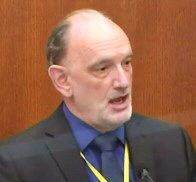 Dr. David Fowler, a forensic pathologist, was the sole witness. He recently retired as Maryland’s chief medical examiner. Dr. Fowler testified that after reviewing all available materials, he concluded that Mr. Floyd suffered a “sudden cardiac arrhythmia” during his restraint due to pre-existing vascular and heart problems (click on photo for clip.) Commenting on the coroner’s report (see Day 10) Dr. Fowler said he would move up heart disease from “other conditions” to “cause of death.” Contributing conditions included the presence of fentanyl and methamphetamine in his system, potential CO2 poisoning from the exhaust of the police car that he was lying next to, and the stress of being stopped, which could have cause his blood pressure to spike. Dr. Fowler also referred to studies that concluded prone positions, with or without weight, did not significantly affect respiration. He testified that none of Chauvins’ knee placements depicted on the videos affected any of Mr. Floyd’s “vital structures.” He also rejected hypoxia as a cause. Its onset is very gradual due to the presence of oxygen in the blood. In contrast, Mr. Floyd was “coherent and understandable” until he suddenly ceased moving. He also thought fentanyl was likely involved. He considers it a very powerful narcotic that can interfere with respiration. Dr. David Fowler, a forensic pathologist, was the sole witness. He recently retired as Maryland’s chief medical examiner. Dr. Fowler testified that after reviewing all available materials, he concluded that Mr. Floyd suffered a “sudden cardiac arrhythmia” during his restraint due to pre-existing vascular and heart problems (click on photo for clip.) Commenting on the coroner’s report (see Day 10) Dr. Fowler said he would move up heart disease from “other conditions” to “cause of death.” Contributing conditions included the presence of fentanyl and methamphetamine in his system, potential CO2 poisoning from the exhaust of the police car that he was lying next to, and the stress of being stopped, which could have cause his blood pressure to spike. Dr. Fowler also referred to studies that concluded prone positions, with or without weight, did not significantly affect respiration. He testified that none of Chauvins’ knee placements depicted on the videos affected any of Mr. Floyd’s “vital structures.” He also rejected hypoxia as a cause. Its onset is very gradual due to the presence of oxygen in the blood. In contrast, Mr. Floyd was “coherent and understandable” until he suddenly ceased moving. He also thought fentanyl was likely involved. He considers it a very powerful narcotic that can interfere with respiration.
On cross examination, the prosecutor repeatedly criticized Dr. Fowler for “trying to confuse the jury.” He complained that Dr. Fowler did not add Chauvin’s police equipment to his weight, that he suggested without proof that “the white substance” on Mr. Floyd “was a pill,” and that he misconstrued another expert’s views about the risks of the prone position. Dr. Fowler agreed that it takes four minutes of no supply of oxygen to the brain to cause irreversible damage, and that death always involves a fatal arrhythmia. He conceded that none of the studies 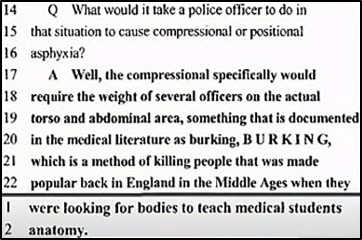 he cited that questioned positional asphyxia (they used experimental subjects) involved a knee on the neck or matched the length of Mr. Floyd’s forceful detention. He was also reminded about his testimony in an earlier case (see graphic on left) where he said that “the weight of several officers” could cause compressional asphyixia. Dr. Fowler’s representation of Mr. Floyd’s death as “sudden” (i.e., a heart attack) was also challenged. Dr. Fowler explained that he meant a sudden cardiac arrest. “The moment of death is not something you can easily document.” He did agree, though, that Mr. Floyd should have been given prompt medical attention to reverse the cardiac arrest. he cited that questioned positional asphyxia (they used experimental subjects) involved a knee on the neck or matched the length of Mr. Floyd’s forceful detention. He was also reminded about his testimony in an earlier case (see graphic on left) where he said that “the weight of several officers” could cause compressional asphyixia. Dr. Fowler’s representation of Mr. Floyd’s death as “sudden” (i.e., a heart attack) was also challenged. Dr. Fowler explained that he meant a sudden cardiac arrest. “The moment of death is not something you can easily document.” He did agree, though, that Mr. Floyd should have been given prompt medical attention to reverse the cardiac arrest.
Day 14 - Thursday, April 15 (for the trial video click here)
Outside the jury’s presence, Chauvin was asked by his lawyer whether he intended to testify. Here is a video clip of his response (click image to play):
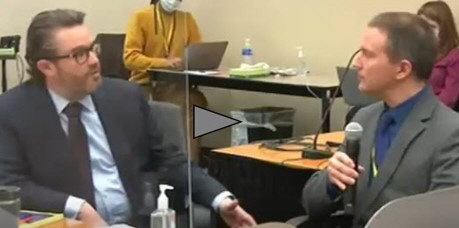
REBUTTAL TESTIMONY BY PROSECUTION
Mr. Chauvin elected not to testify, and the defense rested its case.
The State recalled its witness from Day 9 (April 8), Dr. Martin Tobin, a pulmonary and critical care physician. He had testified that “Mr. Floyd’s prone position, the officers’ tight physical hold, and particularly Chauvin’s pressure with his knees on the neck and elsewhere, ‘enormously impaired’ Mr. Floyd’s ability to breathe.” He promptly discounted defense expert Dr. Fowler’s testimony on the prior day that Mr. Floyd might have suffered from CO2 poisoning. According to Dr. Tobin, Mr. Floyd’s blood was analyzed shortly after his arrival at the hospital and its hemoglobin was found to be 98 percent saturated with oxygen. Thus, his CO2 levels were definitely within the “normal range.”
BOTH SIDES REST
Both sides rested. Jurors were asked to return Monday for closing arguments. They were also cautioned that they would be sequestered throughout their deliberations.
WEEK 4
Day 15 Day 16 Verdict
Day 15 - Monday, April 19 (for the trial video click here)
For jury instructions click here
CLOSING ARGUMENTS
Prosecution
Prosecutor Steve Schleicher offered a graphic description of George Floyd’s struggle to survive. Trapped between the officers and the pavement, a knee pressing on his neck and another on his back, he couldn’t expand his lungs sufficiently to breathe. It was like being squeezed in a vise. Floyd’s heart failed because he was deprived of oxygen. His last words to “Mr. Officer” were “please, I can’t breathe.” Yet despite knowing about the dangers of positional asphyxia and warnings from bystanders and colleagues that Mr. Floyd wasn’t breathing, Chauvin relentlessly maintained pressure until an ambulance attendant intervened. “Believe your eyes,” the prosecutor implored jurors. “Believe what you saw.”
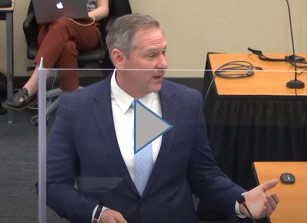 Mr. Schleicher called police work “a noble profession.” He insisted that the case “is not a prosecution of the police” but of the defendant. Chauvin’s actions, he said, were not what one would expect from a reasonable police officer. Force isn’t authorized just because someone is “on something.” He violated his own agency’s rules on use of force and ignored his responsibility to provide care. “There’s a duty to provide medical assistance...You’re required to perform CPR.” Bottom line: Chauvin committed an “assault.” (Click on the image for the prosecutor’s comments about murder.) Mr. Schleicher called police work “a noble profession.” He insisted that the case “is not a prosecution of the police” but of the defendant. Chauvin’s actions, he said, were not what one would expect from a reasonable police officer. Force isn’t authorized just because someone is “on something.” He violated his own agency’s rules on use of force and ignored his responsibility to provide care. “There’s a duty to provide medical assistance...You’re required to perform CPR.” Bottom line: Chauvin committed an “assault.” (Click on the image for the prosecutor’s comments about murder.)
Mr. Floyd, argued the prosecutor, posed absolutely no threat. He was surrounded, handcuffed and on his knees. “Being large and being on something is not a justification for the use of force.” Stricken by anxiety and claustrophobia, he only resisted when officers shoved him into the back of a small squad car. “He wasn’t able to bring himself to do it.” According to Mr. Schleicher, police frequently deal with people in crisis, and this was no different. Floyd even thanked the officers for bringing him out. Dealing with him only required compassion, but none was shown.
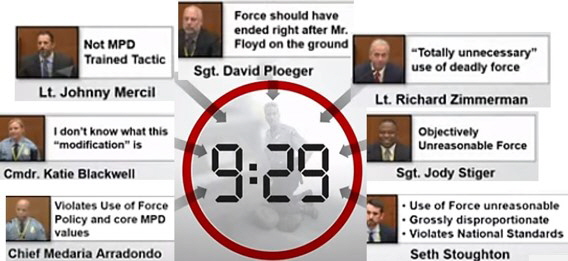 |
Prosecutor Schleicher emphasized that the State’s police officer witnesses, including Chauvin’s own former chief, denounced the defendant’s behavior (see above graphic.) “These actions were not policing, these actions were an assault.” He also ridiculed the testimony of witnesses presented by the defense. “You’re not required to accept nonsense,” he argued. That “nonsense” included assertions that the prone position did not cause pain, that bystanders were at fault for presenting a distraction, and that vehicle exhaust and “excited delirium” were to blame.
Admittedly, Mr. Floyd did abuse drugs. But the prosecutor pointed to the conclusion by a State medical expert, who found that the tiny quantity of fentanyl in Mr. Floyd’s system and his swift death ruled out an overdose. Neither was there any evidence of a “a sudden cardiac arrythmia” or a heart attack. Mr. Floyd’s ability to take in oxygen was taken away. It was simple as that.
Defense
Defense lawyer Eric Nelson began by emphasizing that Chauvin arrived to find a large suspect fighting two officers. Under such circumstances, his training gave him several options: one was a “controlled takedown,” another a “conscious neck restraint.” A “reasonable police officer” would have also recognized that the white foam around Mr. Chauvin’s mouth (a graphic photo was shown) suggested that he was on drugs.
According to Mr. Nelson, everyone agreed that the use of force was reasonable until that “nine minute and twenty-nine second period.” By harping on that, he said, the prosecution ignored what had transpired during the previous sixteen-plus minutes, which a “reasonable police officer” would take into account. “Human behavior is unpredictable.” Police officers know that suspects can quickly become non-compliant. Mr. Nelson also showed a video of the increasingly hostile crowd. He argued that citizens were displaying “potential signs of aggression,” so officers had to remain calm and nonplussed.
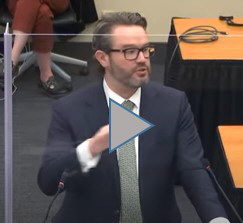 Turning to Chauvin’s use of force, Mr. Nelson stated that an expert endorsed the manner of Mr. Floyd’s restraint, including the “knee on the neck.” Continued restraint, he said, is often necessary because even handcuffed persons can “thrash around” and pose a risk. Mr. Nelson pointed to research findings that demonstrated prone restraints were safe. He argued that in their quest to prove that positional asphyxia was solely to blame prosecutors had experts assert the implausible: that pre-existing health problems including heart conditions, hypertension, drug use, excited delirium, and so on “played absolutely no role” in Mr. Floyd’s death (for some of his remarks click on the image.) Turning to Chauvin’s use of force, Mr. Nelson stated that an expert endorsed the manner of Mr. Floyd’s restraint, including the “knee on the neck.” Continued restraint, he said, is often necessary because even handcuffed persons can “thrash around” and pose a risk. Mr. Nelson pointed to research findings that demonstrated prone restraints were safe. He argued that in their quest to prove that positional asphyxia was solely to blame prosecutors had experts assert the implausible: that pre-existing health problems including heart conditions, hypertension, drug use, excited delirium, and so on “played absolutely no role” in Mr. Floyd’s death (for some of his remarks click on the image.)
Mr. Nelson criticized prosecution experts as hopelessly biased. He pointed to testimony by a pulmonologist who testified that a video image showed Mr. Floyd trying to push himself off the ground. Citing the time on the clip, Mr. Nelson said that event took place only seconds after Mr. Floyd was placed on the ground, and well before he was turned on his stomach. Mr. Nelson then turned to an image of Chauvin’s knee on Mr. Floyd’s neck. Chauvin’s toes were off the ground. According to a prosecution expert, that proved that Chauvin was exerting great pressure. But when Mr. Nelson played the full clip, it was evident that Chauvin’s toes were constantly going up and down.
Be sure to check out our homepage and sign up for our newsletter
Chauvin’s lawyer was particularly critical of prosecution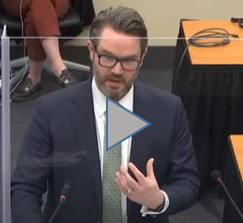 witnesses for dismissing out of hand the likelihood that drugs may have contributed to Mr. Floyd’s death. Yet Mr. Floyd fell fast asleep after returning to the car and his passengers could not wake him up. Methamphetamine - one of the two drugs he ingested - causes the heart’s arteries to constrict. And Mr. Floyd’s right coronary artery was ninety percent blocked. Yet “every single doctor just brushed it aside...It’s preposterous....” (click on the image for his closing remarks.) witnesses for dismissing out of hand the likelihood that drugs may have contributed to Mr. Floyd’s death. Yet Mr. Floyd fell fast asleep after returning to the car and his passengers could not wake him up. Methamphetamine - one of the two drugs he ingested - causes the heart’s arteries to constrict. And Mr. Floyd’s right coronary artery was ninety percent blocked. Yet “every single doctor just brushed it aside...It’s preposterous....” (click on the image for his closing remarks.)
Chauvin’s defense lawyer also commented about the delay in getting Mr. Floyd to the hospital. What if the ambulance had not paused enroute? Mr. Nelson said that he wasn’t blaming paramedics. However, their actions reflected the fallibility of well-intentioned decisions that are made “under highly stressful situations.”
Day 16 - Tuesday, April 20 (for the full verdict video click here)
 VERDICT VERDICT
After deliberating about one day, jurors returned a verdict finding Chauvin guilty of each charge: second-degree murder, third-degree murder and second-degree manslaughter. His bond was revoked. Chauvin will apparently be sentenced in two months. Click on the image for a clip of the reading of the verdict.
POST-TRIAL MOTIONS, SENTENCE AND UPDATES (scroll)
11/27/23 Ex-Minneapolis cop Derek Chauvin, who is serving concurrent Federal and State twenty-years-plus sentences at a Federal prison in Arizona, has been hospitalized after his stabbing by a fellow inmate on November 24. Beyond confirming that Chauvin “is expected to survive,” authorities have not released any information about motive or assailant. Concerns that Chauvin is especially vulnerable to attack previously led to his sequestration, and it’s assumed that some protective measures continue.
11/22/23 Derek Chauvin’s final attempt to reverse his State conviction for murdering George Floyd has fallen on deaf ears. On November 20 the Supreme Court rejected his contention that pre-trial publicity and public protests denied him the right to a fair trial. Minnesota’s high court came to the same conclusion in July. (See 4/18/23 update)
5/23/23 “Break the Wheel: Ending the Cycle of Police Violence,” a new book by Minnesota Attorney General Keith Ellison, describes behind-the-scenes work by state prosecutors to gain the conviction of Derek Chauvin for murdering George Floyd. According to Ellison, the State’s evidentiary approach was heavily influenced by trial runs with mock juries, which revealed that ordinary citizens were far more concerned about the officers’ failure “to render aid to George Floyd” than about his drug abuse.
4/18/23 Minnesota’s Court of Appeals, the second of three levels of state courts, affirmed Derek Chauvin’s conviction for second-degree (unintentional) murder. Among other things, it concluded that the trial judge took sufficient steps to mitigate the effects of pre-trial publicity, that he properly allowed prosecutors to present seven witnesses as to police use of force, and that his upward departure from presumptive sentencing guidelines was not an abuse of discretion. (See 11/22/23 update)
3/20/23 Ex-Minneapolis cop Derek Chauvin pled guilty to failure to file state tax returns. He drew a 13-month prison sentence, to run concurrently with his 21-year Federal and 22 1/2 year State terms for murdering George Floyd. Chauvin and his ex-wife also failed to report all their income. She recently pled guilty and will draw probation.
1/19/23 Appearing in court to argue his motion for a new trial, the lawyer for convicted ex-Minneapolis cop Derek Chauvin blasted the State for holding the proceedings “in a courthouse that's surrounded by concrete block, barbed wire, two armored personnel carriers and a squad of National Guard troops all ... there for one purpose: in the event that the jury acquits the defendant.” He also challenged one of the jurors for not revealing that he had participated at an “I Have a Dream” event in D.C.
10/28/22 A post-trial motion filed by ex-MPD cop Derek Chauvin challenges his State conviction for murdering George Floyd on various grounds, including juror bias caused by threats and publicity and an insufficient post-encounter “cooling period.” These issues could have been prevented or mitigated had the venue been changed or had the jury been sequestered. Chauvin also objects to the introduction of extraneous evidence and the presentation of “cumulative” testimony on the use of force. (See 4/29 update)
10/21/22 Former Maryland State Medical Examiner Dr. George Fowler testified that George Floyd’s death was due to pre-existing conditions and drug use and was not caused by being pinned down by Chauvin. That case, and others, have led Maryland attorney general Brian Frosh to order a review of 100 autopsies during Fowler’s term of persons who died after police restraint but whose deaths were attributed to other causes. One such case, the death of a teen athlete, had led to a $5 million settlement.
8/26/22 Derek Chauvin has been transferred to a Federal prison, where he is expected to serve about seventeen years of his 21-year Federal sentence for depriving George Floyd of his civil rights. His State term of 22 1/2 years for murdering Mr. Floyd will run concurrently.
8/10/22 Ramsey County, Minnesota, in whose jail Chauvin was held after his arrest, agreed to pay a total of $1.5 million in damages to eight correctional officers who were prohibited from interacting with Chauvin because they are not White. Their orders came from a former superior who said he was concerned that the employees could be “traumatized” by dealing with Chauvin. “Darker skinned” officers were reassigned from Chauvin’s floor and he was allegedly given special privileges by a White officer.
7/8/22 “You absolutely destroyed the lives of three young officers” said Federal judge Paul Magnuson as he sentenced ex-MPD cop Derek Chauvin to 21 years imprisonment on his guilty plea to violating George Floyd’s civil rights. Chauvin will have to serve nineteen years, which more than what he would have served for his 22 1/2 year State term. But Chauvin likely prefers to do his time in a Federal lock-up, and both sentences will run concurrently. (See 12/16/21 update) DOJ press release
4/29/22 Chauvin appealed the verdict. Among his objections are pervasive publicity; juror concerns about their safety; use of irrelevant “depraved mind” evidence; introduction of cumulative expert opinions about the use of force; exclusion of evidence that MPD trained officers to place their knees on subjects’ backs; the Court’s refusal to compel one of his passengers to testify; and the Court’s failure to properly interpret use-of-force standards.
1/4/22 Maryland’s Attorney General will begin a review of all autopsies for deaths in police custody conducted during the term of Dr. David Fowler, the State’s retired Chief Medical Examiner. Dr. Fowler was a defense witness in the trial of Derek Chauvin for murdering George Floyd. Dr. Fowler testified that Mr. Floyd suffered a “sudden cardiac arrhythmia” due to pre-existing vascular and heart problems, compounded by the use of drugs. That has led to concerns that he was biased for police from the start.
12/16/21 Derek Chauvin pled guilty to Federal deprivation of rights charges in two distinct cases. He admitted using “unreasonable and excessive force” against George Floyd on May 25, 2020, and that he did so in a “callous and wanton” manner that disregarded the likely consequences. He also pled guilty to violating the rights of a 14-year old boy on Sept. 4, 2017, repeatedly striking the youth with a flashlight and pinning him to the ground for a prolonged period although he was handcuffed and unresisting. (Along with Lane, Kueng and Thao, he originally pled not guilty.)
6/25/21 Sentencing. Judge Peter Cahill sentenced Chauvin to a term of 270 months (22 1/2 years) for unintentional second-degree murder while committing a felony, with credit for 199 days served. As Minnesota law provides, the sentence reflects only the most serious charge for which Chauvin was convicted. In his ruling, Judge Cahill wrote that aggravating circumstances including Chauvin’s abuse of his position, failure to render aid and especially cruel treatment of Mr. Floyd warranted an upward departure from the guideline sentence of 150 months (click here for the judge’s order). Assuming good behavior, Chauvin will be eligible for parole after serving two-thirds of his term, 180 months (15 years.)
6/24/21 Denial of request for new trial; sentencing. On June 24, 2001 Judge Peter Cahill ruled that Chauvin had failed to prove that a juror committed misconduct and denied his request for a new trial (click here for the judge’s order).
6/2/21 Sentencing memoranda by prosecution (click here) and defense (click here). On June 2, 2021 prosecutors moved that Judge Cahill impose a thirty-year prison term. In their view, a sentence “twice the upper end of the presumptive sentencing range” is justified by case law and the judge’s finding that four aggravating factors exist. Only such a sentence, they argued, “would properly account for the profound impact of Defendant’s conduct on the victim, the victim’s family, and the community.”
Defense lawyer Eric Nelson argued that Chauvin be granted time served and probation, or if not, then given the benefit of a “downward durational departure” from the presumptive term. In his view, “Mr. Chauvin did not intend to cause George Floyd’s death. He believed he was doing his job. The facts of Mr. Chauvin’s case certainly cannot place his offense among the most egregious of all unintentional murder cases such that no mitigated departure is warranted.”
5/14/21 Citing a need for “space” from events, and from the recent Federal civil rights indictment of Chauvin and his colleagues, Judge Peter Cahill rescheduled the trial of former officers Lane, Kueng and Thao from this August to March 7, 2022. Judge Cahill also agreed to hear a defense motion that asserts a fair trial was made impossible by the New York Times’ leak of a plea deal with Chauvin. Prosecutors have steadfastly denied being the source.
5/11/21 Upward sentencing departure granted. Under Minnesota court rules Chauvin had “the right to a jury trial” to determine whether aggravating factors are present to justify the upward sentencing departure demanded by prosecutors. But he deferred that judgment to Judge Peter Cahill. Judge Cahill ruled that four such factors were indeed present: (1) Chauvin “abused a position of trust and authority”; (2) he demonstrated “particular cruelty”; (3) “children were present” (as spectators); and (4) the crime was committed with the participation of others. According to a legal expert, these factors will likely increase Chauvin’s sentence from the 12 1/2 year term called for by sentencing guidelines to thirty years, with twenty served in confinement.
5/7/21 A Federal Grand jury indicted Derek Chauvin and his three colleagues, Tou Thao, J. Alexander Kueng and Thomas Lane for violating the Federal civil rights of George Floyd, both through their actions and by failing to render aid. In addition, Chauvin is separately accused of violating the civil rights of a 14-year old whom he held “by the throat” and struck “multiple times in the head with a flashlight” in 2017.
5/4/21 Motion for a new trial and to “impeach” the verdict. Chauvin’s lawyer moved for a new trial. He argued, among other things, that the judge erred by failing to grant a change of venue and by not sequestering the jury throughout, thus exposing it to prejudicial and intimidating publicity. “The publicity here was so pervasive and so prejudicial before and during this trial that it amounted to a structural defect in the proceedings.” Eric Nelson also claims that the judge erred in not compelling Mr. Floyd’s friend to testify (he was the male passenger who supposedly removed objects from the car) and by refusing to admit into evidence his statements to police. Chauvin’s lawyer also moved to “impeach the verdict” on grounds that jurors had been intimidated and subjected to “race-based pressure” throughout the proceedings.
4/21/21 One day after the conviction of former Minneapolis officer Derek Chauvin, DOJ announced that it will conduct a “patterns and practices” investigation of the Minneapolis Police Department: “The investigation will assess all types of force used by MPD officers, including uses of force involving individuals with behavioral health disabilities and uses of force against individuals engaged in activities protected by the First Amendment. The investigation will also assess whether MPD engages in discriminatory policing.”
|
Did you enjoy this post? Be sure to explore the homepage and topical index!
Home Top Permalink Print/Save Feedback
RELATED POSTS
In Two Fell Swoops Slugging it Out Before the Fight Punishment Isn’t a Cop’s Job
Violent and Vulnerable Three Shootings
Posted 3/16/21
TRIAL OF DEREK CHAUVIN:
SLUGGING IT OUT BEFORE THE FIGHT
Pretrial evidentiary battles give the State an edge
For Police Issues by Julius (Jay) Wachtel. On Monday, March 8, just as we found a comfortable place from which to watch the first-ever nationally televised trial of an allegedly murderous ex-cop, there came the disturbing news that prosecutors wanted the Court of Appeal to suspend the proceedings. Their action was prompted by the court’s decision to dismiss the third-degree murder count because there was no proof that Derek Chauvin’s actions had been “eminently dangerous to others,” meaning someone other than George Floyd:
609.195 MURDER IN THE THIRD DEGREE. (a) Whoever, without intent to effect the death of any person, causes the death of another by perpetrating an act eminently dangerous to others and evincing a depraved mind, without regard for human life, is guilty of murder in the third degree and may be sentenced to imprisonment for not more than 25 years.
That seems clear enough. But obfuscation is the law’s bread-and-butter. In a recent, mind-bogglingly complex decision the appellate court let another former cop’s third-degree murder conviction stand although he, too, had only targeted a single person. But the trial judge in this case reasoned that the decision lacked precedential value as it was under appeal to the state supreme court. This clearly miffed the appeals panel, which promptly ordered that the trial judge “reconsider” things. Prosecutors also worried; should a problem arise during trial, it might be preferable to give jurors a place to land other than second-degree manslaughter, a lesser charge that lacks the punch of “murder”.
Click here for the complete collection of George Floyd essays
They didn’t have long to wait. On the third day, with six jurors already seated, the judge caved and reinstated the 3rd. degree murder count. Bottom line: Chauvin will stand trial for second-degree murder, third-degree murder and second-degree manslaughter, just as the State originally intended.
And that’s only a small slice of the duel. As required, Chauvin’s lawyer disclosed the defenses he will argue at trial. There are three: Chauvin had to protect himself, he used reasonable force, and he obeyed the requirements of Minnesota use of force law. Prosecutors will seek to prove otherwise. They are anxious to demonstrate that the George Floyd episode was not an outlier and that Chauvin regularly used compliance techniques that he knew presented a lethal threat. Fierce battles are underway over what evidence will be admitted. Here are some highlights, with links to the actual documents.
Motions by the defense
Minnesota Rule 404, which regulates the use of character evidence, allows defendants to bring up a “pertinent trait of character of the victim of the crime” (meaning, in this case, George Floyd.) In August 2020 Chauvin and co-defendant J. Alexander Kueng moved to introduce evidence of a May 6, 2019 episode in which police moved in as Floyd dealt drugs:
When approached by police he placed drugs in his mouth in an attempt to avoid arrest, and swallowed them. When interacting with police he engaged in diversionary behavior such as crying and acted irrationally.
Officers took Floyd to the hospital. That’s when he allegedly told medical staff that he “snorts oxycodone daily...and has been abusing opiates for the last year and a half.” And should jurors not get too worked up over low-level drug dealing, Chauvin’s lawyer had (that’s right, had) a real ace up his sleeve:
Mr. George Floyd, under the pretenses of being with the water department and thoughtfully disguised by wearing a blue uniform, forcibly entered a home to steal drugs and money. In the course of the robbery Mr. Floyd placed a gun on a woman’s abdomen, allowed her to be pistol whipped by an accomplice and demanded drugs and money.
“Punishment Isn’t a Cop’s Job” sets out George Floyd’s substantial criminal record in his home state of Texas, where he served a prison term for the robbery. Chauvin’s lawyer probably figures that if this couldn’t shatter Floyd’s guise as a victim and destroy his credibility, nothing can.
On January 15, 2021 Chauvin’s lawyer announced his intention to introduce medical and other “scientific” testimony about Floyd, perhaps including a psychological assessment, from Dr. David Fowler and his colleagues at “The Forensics Panel.” And on February 8 he submitted a comprehensive, thirty-seven point motion that, in part, sought to keep all “citizen complaints” about his client, whether or not sustained, out of the trial. He also wants to bar other cops from opinionating about his client’s techniques, and paramedics from speculating about the cause of Floyd’s death.
A key area of concern is the private autopsy performed by Dr. Michael Baden, who attributed Floyd’s death to pressure on the neck. That’s led the defense to vigorously oppose introducing medical exams not performed by the County medical examiner. His initial autopsy report ruled out “life-threatening injuries” and noted that Floyd’s system brimmed with powerful drugs. (An update, however, mentioned that Floyd had been physically restrained and classified his death as a “homicide.” Still, the most proximate official cause of death remains “cardiopulmonary arrest.”)
George Floyd’s demise was a public spectacle, and anyone who observed his treatment could ostensibly testify as to what they saw. Fearing that she might “spin” things in an uncomfortable way, the defense opposed “speculation” by Genevieve Hanson, an off-duty firefighter who reportedly begged officers to check Mr. Floyd’s pulse. Chauvin’s lawyer is also worried about a man who berated police during the encounter (his words were captured by an officer’s bodycam):
He is not even resisting arrest. You think that's cool? What's your badge number? You're a bum for that. You're a bum for that, bro. He's not responsive right now. You call what he's doing OK?
Donald Williams can’t be kept off the stand. But the defense vigorously objected to any mention that he’s an expert in the martial arts.
Motions by prosecutors
Prosecutors well know that anything that makes George Floyd look bad could sway juror sympathies in the defendant’s direction. In a lengthy, mind-numbing brief prosecutors oppose any reference to Mr. Floyd’s past behavior. They argue, for example, that the circumstances of Floyd’s drug arrest/drug ingestion a year earlier were “markedly dissimilar” from what Chauvin and his helpmates encountered on that fateful day. Maybe Mr. Floyd did pop a pill; maybe he didn’t. Either way, mentioning it would prejudice the jury. Ditto his robbery conviction.
Prosecutors are also naturally eager to make Mr. Floyd seem as “normal” as possible. On February 8 they moved to bar the admission of a series of slides about Excited Delirium, a potentially lethal condition that can supposedly stop the heart of heavy drug users who become overly agitated. (Indeed, Thomas Lane, the first cop to interact with Floyd, expressed concern that he might be in the clutches of this syndrome.) Prosecutors have also filed a motion that seeks to restrict Dr. Fowler’s testimony to what he personally knows and does not include assessments made by other members of “The Forensic Panel.”
Rule 404 isn’t just about victims. Its provisions allow the State to prove a defendant’s “motive, opportunity, intent, preparation, plan, knowledge, identity, or absence of mistake or accident” with “clear and convincing evidence” of past “crimes, wrongs or acts.” Its probative value, though, must outweigh the “potential for unfair prejudice.”
To prove that Chauvin breached established law enforcement standards and violated Minneapolis PD policy prosecutors intend to bring in MPD training materials. And to demonstrate that Chauvin’s use of force against Mr. Floyd was nothing new they moved to admit seven instances since 2014 in which he allegedly applied pressure to the neck area of prone suspects. Here’s one example:
On June 25, 2017, Defendant restrained an arrested female by placing his knee on her neck while she laid in prone position on the ground. Defendant shifted his body weight onto the female’s neck and continued to restrain the female in this position beyond the point when such force was needed under the circumstances.
In an earlier episode Chauvin reportedly observed his colleagues use a similar approach on a “suicidal, intoxicated, and mentally-disturbed male”:
Defendant observed other officers fight with and tase the male [and] place the male in a side-recovery position, consistent with training...Officers...received a commendation for their appropriate efforts and received feedback from medical professionals that, if officers had prolonged their detention of the male or failed to transport the male to the hospital in a timely manner, the male could have died.
Did Chauvin know that a forceful, “prolonged detention” of the kind he favored could prove fatal? If so, Bingo!
Prosecutors have vigorously objected to defense motions that would restrict testimony from other police officers. On March 4 they filed a lengthy, highly detailed motion insisting that Chauvin’s colleagues be allowed to testify as to how Floyd’s arrest should have been handled “in light of Minneapolis Police Department (MPD) policies and training.” They also rejected the defense attempt to limit the testimony of passers-by Hanson and Williams.
Outcomes
So far the State seems well ahead. On January 26, 2021 the judge ruled that the defense could not bring up George Floyd’s drug arrest [modified 3/19. See 3/20/21 update]. Nor his alleged comments about drug use. Nor his conviction. Prosecutors, on the other hand, got the green light to cite one prior example (that 2017 episode with the female) of Chauvin’s use of the problematic restraint technique. And as long as there was “clear and convincing evidence” that Chauvin heard their comments, what hospital staffers said about the restraint technique’s potentially lethal effects also got the green light.
Be sure to check out our homepage and sign up for our newsletter
Both passers-by were also cleared for takeoff. While the judge barred Ms. Hanson from saying that “she could have saved” Mr. Floyd’s life, the firefighter will nonetheless be allowed to discuss her training and experience. She’ll be able to mention “indications Mr. Floyd was in medical distress” and opine that “medical intervention should have been started.” Mr. Williams, in turn, was cleared to mention his martial-arts background. And even to mention “blood chokes.” Oops!
Full stop. On Friday, March 12, Minneapolis settled the lawsuit filed by George Floyd’s family for a record-breaking $27 million, assertedly “the largest [payout] in a civil rights wrongful death lawsuit in U.S. history.” Attacking the settlement’s “very suspicious” timing and “incredible propensity to taint the jury pool,” the defense moved for a delay. But while the judge seemed troubled (“I wish city officials would stop talking about this case so much”) he kept things moving along. As of this writing nine of fourteen jurors (twelve plus two alternates) have been seated, and seven will be recalled so they can be questioned about their reaction to the settlement.
We’ll have more to say during the trial. Stay tuned!
UPDATES (scroll)
3/7/21 “If the right thing isn’t done, I’m afraid chaos will erupt.” That’s what Selwyn Jones, George Floyd’s uncle, predicts will happen should ex-cop Chauvin be acquitted. Jury selection for his trial is scheduled to begin on March 8, but due to COVID restrictions the public will not be admitted. Mr. Jones, a South Dakota resident, said he would travel to Minneapolis to join in the protests. Authorities, who fear that violence will break out whatever the verdict, have planned for massive demonstrations. Meanwhile the area where Mr. Floyd lived is plagued by robberies and shootings. Police closed the local precinct house, and residents complain they’ve been abandoned. Click here for details about the trial.
3/6/21 Observers suggest that Derek Chauvin’s many gigs handling security for various businesses, including a decade-plus stint at a nightclub, may have overworked him and contributed to his reported aggressiveness in those capacities, as well as a cop. Minneapolis officers’ private employment has led to many lawsuits, including a large recent payout to a citizen who claimed that he was seriously injured by an off-duty cop in 2017.
3/2/21 Concerns that jurors might be reluctant to convict Derek Chauvin of second-degree murder, which, if unintentional, requires proof that an accused was committing felony assault, has led prosecutors to petition the Court of Appeals to reinstate the third-degree murder charge. That was thrown out by a District Court judge who said it required that persons other than Mr. Floyd were placed at risk. But the appeals court recently allowed the third-degree murder conviction of former officer Mohamed Noor to stand even though he only “targeted” one person.
2/11/21 According to the New York Times, A.G. William Barr turned away Derek Chauvin’s offer, which had supposedly been endorsed by county officials, to plead guilty to 3rd. degree murder in exchange for no Federal civil-rights prosecution. Chauvin’s offer came three days after Mr. Floyd died, and A.G. Barr reportedly worried about public reaction.
2/2/21 Two prior uses of force by Derek Chauvin, the ex-Minneapolis officer who held down George Floyd by leaning on his neck, will be introduced at his murder trial. One is a June 2017 arrest in which he did the same to a woman, and another is a similar incident in 2015. But the judge denied prosecutors’ bid to bring up other instances of alleged physical abuses by Chauvin, or any by officers Thao and Kueng, who are being tried separately. Defense requests to introduce Floyd’s prior arrests, including one in which he allegedly behaved similarly to the fatal encounter, were also denied.
1/14/21 Derek Chauvin, the former Minneapolis police officer accused of killing George Floyd, will be tried separately. His trial for 2nd. degree murder and manslaughter is scheduled for March 8. His three colleagues: J. Alexander Kueng, Thomas Lane and Tou Thao, will be tried jointly for aiding and abetting Chauvin. Their trial is scheduled for August 23. All four officers were fired and are on high bonds.
10/23/20 The presiding judge eliminated the third-degree murder charge against Chauvin as technically unsustainable. But the more serious, 2nd. degree murder was allowed. He also refused to dismiss the aiding and abetting murder and manslaughter charges against Chauvin’s colleagues. Whether the officers will be tried jointly or separately is yet to be decided.
10/16/20 The judge presiding over the officers’ prosecution will allow the defense to introduce evidence of a May 2019 traffic stop during which Floyd apparently swallowed a large quantity of pills and exhibited similar noncompliant behavior. Medical help was summoned and he was rushed to the hospital because of dangerously elevated blood pressure.
9/13/20 Prosecutors filed a written notice of their intent to offer evidence that, before his contact with Mr. Floyd, Chauvin had inappropriately used neck restraints on eight occasions since 2014.
9/12/20 Hennepin County District Court hearing (9/11). Chauvin, in custody, charged with second-degree unintentional murder, third-degree murder and second-degree manslaughter. Three officers, out on bond, charged with aiding and abetting murder and manslaughter.
- The Judge rejected defense lawyer requests to admit evidence of Floyd’s involvement in a 2019 drug case in Minneapolis and a 2007 drug-related robbery in Texas.
- Prosecutors asked that the cases against the four officers be consolidated into one trial.
- Citing local bias, each defense lawyer asked for a change of venue. Each also moved for a dismissal. Chauvin’s lawyer said his client acted carefully and Floyd died from drug intoxication. Kueng’s lawyer (Chauvin’s partner) said what his client did was “reasonable” and that he did not know Chauvin was about to commit a crime. Lane’s lawyer (his client made the initial contact) said Floyd resisted getting out of the car. And the lawyer for the fourth officer, Thao, said his client focused on crowd control and had no input on what otherwise took place.
7/18/20 A New York Times profile of Derek Chauvin paints him as a “quiet and rigid workaholic with poor people skills and a tendency to overreact” whom most other officers tended to avoid.
6/3/20 Prosecutors filed an additional count against Chauvin, charging him with second-degree murder, which requires proof that harm (though not death) was intended. Each of the other three officers was charged with aiding and abetting both second-degree murder and manslaughter.
6/4/20 A New York Times article about the ex-officers and their backgrounds mentions that Lane, 37, had only a few days on the job. Ex-officer Kueng, 26 and African-American, was on his third shift. His “main training officer” was Chauvin. Their lawyers said both repeatedly told Chauvin “you shouldn’t do this.” The third ex-cop, Thao, has reportedly cooperated with prosecutors in their case against Chauvin.
A white Minneapolis woman said she formally complained in 2007 after Chauvin dragged her out of her car without reason, as her baby cried for milk, and sat her in the patrol car. His partner said her vehicle “matched” that of a suspect. Chauvin was reportedly issued a written reprimand.
|
Did you enjoy this post? Be sure to explore the homepage and topical index!
Home Top Permalink Print/Save Feedback
For the Minneapolis Star-Tribune daily wrapup of what happened during the trial, click here
RELATED POSTS
The Trial of Derek Chauvin Punishment Isn’t a Cop’s Job Violent and Vulnerable
Three Shootings
MINNESOTA PRETRIAL FILINGS, BY DEFENDANT
Derek Chauvin Alexander Kueng Thomas Lane Tou Thao
|